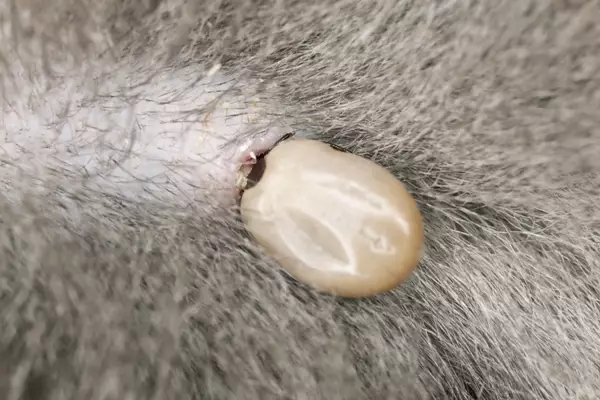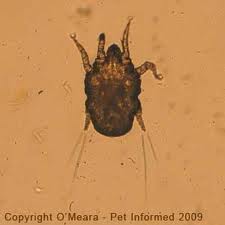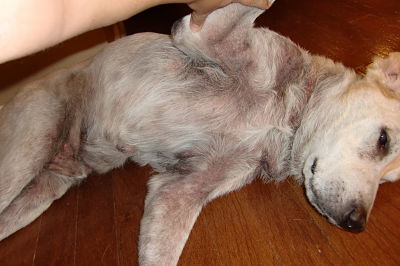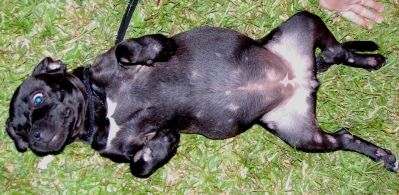Dog Has Bumps All Over Back and Sides With Hair Loss
Is your dog constantly scratching or biting at an itch? Does it have bald patches or smelly skin? The dog's skin is the largest organ of its body, and the skin and hair together are described as a dog's coat. They say that the coat is the mirror of a dogs health, and it is true that you can often see by the condition of the coat if the dog is glowing with good health or is starting to have health issues.
If your dog's coat is nice and shiny and no hair loss or bald patches are present, it is a good indication that your dog is healthy and is getting the right amount of nutrition from its food. On the other hand, if your dog's hair is looking dull or a large amount of hair is being lost (more than the normal loss from a winter to summer coat), you should take action and get your dog's health checked. Dog hair loss can give a dog owner a first indication that something is not quite right with their dog.
Dog hair loss can be caused by many different factors and there are a number of different dog hair loss treatments available. In this article we help you to understand everything you need to know about dog hair loss and its potential symptoms and causes, how to prevent your dog from losing its hair and dog hair loss treatment options.
Other symptoms accompanying dog hair loss
You may notice one or more of these symptoms developing, either before or at the same time hair loss begins:
- Itchy skin – lots of constant scratching
- Dandruff – white dry, flaky skin
- Red skin patches
- Smelly skin – caused by a yeast infection
- Constant licking of a skin patch to ease the itch
- Biting and nipping of skin parts to ease the discomfort
What causes dog hair loss?
Dog hair loss and bald patches on dogs can be caused by many factors, including:
- Change of season
- Parasites like ticks and mites
- Skin fungus
- Stress
- Food allergies
- Environmental allergies
- Hormones
- Poor nutrition
- Medical conditions and genetics
In the following section we will examine each of these factors and their potential contribution to hair loss in dogs.
1) Change of season
The good news is that heavy dog hair loss isn't always caused by sickness, lack of nutrition or allergies; it can simply be caused by your dog's change of coat for the new season. Dog hair loss occurs in most shedding breeds as part of their normal seasonal change in spring and autumn. During spring, dogs lose most of their winter coats. This hair loss is activated through hormonal changes and rising temperatures, as the dog's body prepares itself to cope with warmer summer weather.
To help your dog transition to its new season's coat, daily brushing is recommended.
2) Parasites
Ticks, mites, fleas, lice, ticks and worms are all parasites that can cause dog hair loss. They all cause discomfort for your dog and if not treated, can cause your dog to lose hair. If you think your dog has any of these parasites, consult your vet to find the right treatment.
Ticks

Ticks are probably the most dangerous of all parasites, especially the deadly Paralysis Tick.
Ticks are best removed using special tick tweezers. If the tick is not removed, the dog will scratch and scratch in its attempt to get rid of the tick. From all this scratching, the hair will fall out and the dog can develop a bald patch, which can easily get infected.
Learn more about ticks here.
Mites

(Source: https://iodogtraining-wpengine.netdna-ssl.com/wp-content/uploads/2012/07/Ear-mite-Example.jpg)
Mites are most commonly found in warm, moist areas on your dog's body, such as its ears or armpits. Even if they don't transmit any diseases, mites can still make your dog extremely itchy and cause incredible discomfort. Your dog will scratch until the skin opens, which can then become infected if not treated. To get rid of these annoying little parasites a vet visit is recommended, as a course of antibiotics might be required along with an anti-mite treatment.
Learn more about mites here.
Fleas

Fleas are more common in warmer months and can be caught from other dogs or from dormant flea eggs on rugs and bedding. Your dog will be very itchy and will often try to scratch or bite itself to provide relief. If not treated, all the scratching and biting can cause the dog to lose hair and can lead to bald patches.
To prevent fleas, make sure you regularly use either preventative flea and tick treatments like Nexgard/Bravecto chews or spot-on (topical) treatments like Advantix. There are also natural products on the market like amber collars and cedar oil sprays that offer an alternative to the chemical tablets and spot on treatments.
Once your dog has fleas, anti-flea shampoos or sprays can help to get rid of them, as well as tablets such as Capstar that kill the fleas on the dog. Once infection has occurred, it is important to break the flea cycle, as fleas typically lay eggs in carpets, dog beds and other places in your home, and can lie dormant for months waiting for a host.
Did you know? Fleas can jump from dogs to humans! Even more reason to prevent them on your pets.
Learn more about fleas here.
Lice

(Source: https://cdn.akc.org/Lice.jpg)
Lice not only cause the skin to itch but can also cause skin allergies. This nasty little parasite can cause immense discomfort for your dog and because of the constant scratching, your dog can lose hair and its skin can get infected.
There are various products on the market to prevent lice infesting your dog, such as Dermacare Malaseb Shampoo and Fido's Pyrethrin Shampoo for Dogs and Cats. Before using any of these products, please consult your vet.
Don't just de-louse your dog, make sure you also disinfect and de-louse your dog's bedding, blankets, carpets, soft toys and the furniture it lies on.
Worms

(Source: https://www.wikihow.com/images/thumb/4/40/Identify-Different-Dog-Worms-Step-1-Version-5.jpg/aid1135248-v4-728px-Identify-Different-Dog-Worms-Step-1-Version-5.jpg)
Worms can cause hair loss in dogs by interfering with the dog's ability to process nutrients. Worms live inside the dog and can be transmitted from dog to dog through sniffing or licking each other's anuses. Dogs who have worms typically show signs of being tired and are quicker to fatigue.
Worms are highly contagious, so it is of upmost importance to regularly de-worm your dog. Regular de-worming can not only prevent dog hair loss but also result in a happier, healthier dog.
Learn more about different types of worms in dogs:
Tapeworm
Roundworm
Heartworm
3) Skin Fungus
Sudden hair loss in dogs can be a sign of a fungal infection. There are two common types, the first being a yeast infection caused by the candida fungus. If your dog has low immunity due to a recent cold or malnutrition, it will be more prone to getting a yeast infection. Yeast infections are highly contagious, and must be treated by a vet.

Dog with Yeast Infection (Source: http://www.dog-nutrition-naturally.com/images/Chanceblackskin_opt.jpg)
The other common type of fungal infection is ringworm, which is caused by the dermatophyte fungus. Don't get confused by the name, the ringworm infection is not a worm at all and is only called that because of its appearance. Disinfecting dog beds and dog toys are a must to reduce the spread or reinfection of the dog.

Dog with Ringworm (Source: http://www.dogchatforum.com/images/ringworm-3.jpg)
4) Stress
Sudden dog hair loss without any medical causes can be a symptom of stress. A move, a significant change in life (such as separation from its humans) or even a second dog joining the family can cause your pet to feel stressed. The dog may then engage in self-soothing activities like scratching and paw or tail licking. However, the constant licking or scratching to de-stress can cause bald patch on dogs in the areas where the dog licks and scratches.
Pheromone sprays and collars like ADAPTIL can help the dog to become more relaxed. If you are worried your dog may be experiencing an unhealthy level of stress, please ask your vet or dog behaviourist for advice.
5) Food allergies
If your dog is losing hair and scratching constantly and feeling uncomfortable in its own skin, it could be a sign of your dog having a food allergy. To determine if your dog has a food allergy or intolerance, the vet will typically put your dog on exclusion diet. This involves putting your dog on a basic diet and then starting to slowly reintroduce other foods to the diet to determine what the dog is allergic to. The process can take up to eight weeks and it is important to be very strict during this time and not to add any treats or other food sources to the diet.
Learn more about allergies in dogs here.
6) Environmental Allergies
Just like humans, dogs can be allergic to things in the environment such as grass, plants and dust. These allergies can lead to dog hair loss as the dog is constantly scratching itself in its desire to alleviate its itchy skin.
Allergies are typically treated with antihistamines and cortisone but there is also a product on the market called Apoquel, which can be a life changer for dogs that have allergies year around. For more info about treatment options for your dog, please consult your vet.
Learn more about allergies in dogs here.
7) Hormonal changes
When a dog goes through hormonal changes like pregnancy, lactation or puberty or after being spayed or neutered, its hormone levels change, which can lead to dog hair loss. Old age can also be a cause of dog hair loss, due to diminishing hormone levels. Hormonal causes of dog hair loss usually resolve themselves and do not require any intervention.
8) Poor nutrition
Poor nutrition or a diet of low nutritional value food can also be the cause of a dull coat and dog hair loss. Not all dry foods are going to be suitable for your dog. A large dog breed like a Great Dane will require different nutrition to a working dog like a Kelpie, for example. You can even find breed specific dog kibble which is developed to cater to your dog's specific nutritional requirements.
Many dog owners choose to opt out of commercially designed dry food and cook for their dog, or may decide to change to a raw food diet. If you are thinking of going down either of these routes, in order to avoid malnutrition and potential dog hair loss, you should acquire some scientific nutritional know-how to ensure your dog won't miss out on valuable vitamins and minerals.
There are also many dog hair loss home remedies around. A natural dog hair loss home remedy that many people use is to add apple cider vinegar to the dog's water to boost hair growth, or a spoon of flaxseed oil into their food.
Pet owners are often recommended dog food supplements that contain extra vitamins, minerals and biotin to boost the dog's coat. Natural product like Augustine approved A+ product can potentially help with itchy skin: http://www.augustineapproved.com.au/super_dog.php
9) Medical Conditions & Genetics
Bald patches on dogs or dog hair loss can also potentially be caused by a medical disease, so it is important to take your dog to the vet to determine if there is a medical cause and discuss the dog hair loss treatment options that are available.
Here is a summary of a number of common medical conditions which could cause your dog to lose hair or have bald patches:
Hypothyroidism
Bald patches on dogs can caused by your dog's thyroid not functioning properly, when it is unable to produce enough of the hormone thyroxine which the body requires. To treat this condition, medication can be prescribed which can help the dog's body to produce more thyroxine through its thyroid.
Cushing's Disease
Dog hair loss can also be caused by the production of too much cortisol by your dog's adrenal glands. This disorder is called Cushing's disease and can be treated by your vet.
Another disease which can cause dog hair loss is Atypical Cushing's disease, which occurs when there are elevations in circulating levels of sex hormones from the adrenal glands without elevations in cortisol.
Learn more about Cushing's Disease
Addison's Disease (hypoadrenocorticism)
Addison's disease is the opposite of Cushing's, where the adrenal glands produce fewer corticosteroid hormones than the dog's body requires.
Learn more about Addison's Disease
Alopecia X
Alopecia X, also called Black Skin Disease, is caused by an imbalance of sex hormones. This leads to dog hair loss and the body's inability to regrow the coat. This is coupled with the insufficient production of melatonin, which causes the skin to darken over time. This disease is not very common and can be treated through hormonal intake.
Learn more about Alopecia X
Some dogs have also a genetic predisposition to less hair growth in certain parts of their body, for example between their eyes, ears or even lower necks. There is no medical attention required for this condition, however your vet may recommend applying dog sunscreen during the summer months.
How can you prevent dog hair loss?
In summary, to prevent hair loss in your dog:
- Ensure you keep up with a schedule of regular preventatives like flea and tick treatments and de-worm your dog on a regular basis.
- Feed your dog high quality food that gives your dog enough nutrients and minerals. Avoid foods that have artificial flavours, sugar and other by-products.
- Prepare your dog for stressful situations that can't be avoided or try not to expose your dog to stressful situations that they may lose hair over.
- Take your dog for annual health check-ups at the vet.
- Use natural dog shampoos and conditioners to prevent dry skin and irritations.
Dog Has Bumps All Over Back and Sides With Hair Loss
Source: https://bowwowinsurance.com.au/pet-community/pet-talk/symptoms-causes-and-treatment-for-hair-loss-in-dogs/
0 Response to "Dog Has Bumps All Over Back and Sides With Hair Loss"
Post a Comment